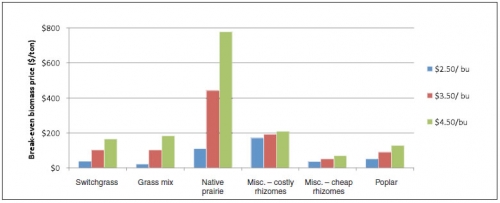Breakeven Price
Break-even price is the price at which revenues equal costs. A comparative break-even price is a similar concept, but it counts as an extra cost the profit earned from the crop being replaced. A break-even price tells a farmer at what point he is covering his costs for a particular crop. A comparative break-even price tells a farmer at what point he is earning more from the new (“challenger”) crop than from the old (“defender”) crop. To find the comparative break-even price, the net revenue from the traditional or most likely to be planted crop is added as an expense to the new crop budget. For the grower to break even, the price must be high enough that the new crop generates revenues to cover all its expenses plus the profit the farmer would have earned planting the traditional crop.
To calculate the comparative break-even price for a biomass crop relative to corn, one needs to know the expected net revenue per acre for corn grain, the expected cost per acre for the biomass crop and the expected yield per acre for the biomass crop. We must also account for the stover that is produced by the corn system. To do this, we simply subtract the stover yield from the expected biomass yield. In this case, the comparative break-even price analysis incorporates the opportunity cost of both the corn grain and the corn stover when determining at what price a biomass crop will break even with a corn system in net revenue.
![]()
We compare the biomass-only crops to corn at corn grain prices of $3.50 per bushel, bracketed by a low price of $2.50 and a high price of $4.50/bu. Miscanthus with cheap rhizomes again stands out as being able to break even with corn at the lowest price of biomass regardless of the corn grain price. The only other crop coming close is grass mix when corn grain is $2.50/bu. The break-even price for miscanthus with cheap rhizomes is $52 per ton at $3.50/bu corn grain, with a range from $33 to $70/ton at corn prices of $2.50 and $4.50/bu. Miscanthus with costly rhizomes, on the other hand, has a very high break-even price regardless of the price of corn. At $3.50 and $4.50 corn, native prairie requires the highest price for biomass to be a justifiable investment because it has the lowest yield of the dedicated biomass crops.
Figure 1. Comparative break-even biomass prices at three corn grain prices.




 Print
Print Email
Email